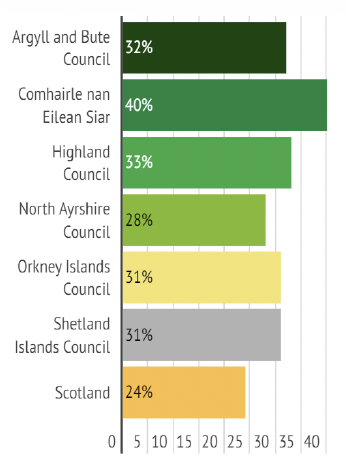Scottish islands: data overview 2023
This report gives a snapshot of Scotland's island-level data as collated in the new Scottish Islands Data Dashboard and draws out key findings relating to each of the strategic objective topic areas set out in the National Islands Plan.
7 Fuel Poverty
Scottish island residents are generally more likely to face fuel poverty than the average Scottish resident. Island and rural local authorities generally had the highest proportion of the least energy efficient dwellings. Additionally, almost two-thirds (65%) of rural dwellings are not connected to the gas grid and therefore rely on more expensive heating fuel such as electricity and oil.
Rates of fuel poverty are generally higher in the island Local Authorities with around a third of residents experiencing fuel poverty in Argyll and Bute (32%), Highland (33%), Orkney Islands (31%) and Shetland Islands (31%) councils and as many as 40% in Na h-Eilean Siar, while the average for Scotland is 24%.
Island and rural local authorities generally had the highest proportion of the least energy efficient dwellings. Additionally, almost two-thirds (65%) of rural dwellings are not connected to the gas grid and therefore rely on more expensive heating fuel such as electricity and oil.

The Fuel Poverty (Targets, Definition and Strategy) (Scotland) Act 2019 defines a household as being in fuel poverty "if, in order to maintain a satisfactory heating regime, total fuel costs necessary for the home are more than 10% of the household’s adjusted net income (i.e. after housing costs), and if after deducting those fuel costs, benefits received for a care need or disability and childcare costs, the household’s remaining adjusted net income is insufficient to maintain an acceptable standard of living. The remaining adjusted net income must be at least 90% of the UK Minimum Income Standard to be considered an acceptable standard of living with an additional amount added for households in remote rural, remote small town and island areas." Source: Scottish House Condition Survey: Local Authority Analysis 2017-2019, Scottish Government (2021)
Contact
Email: socialresearch@gov.scot
There is a problem
Thanks for your feedback